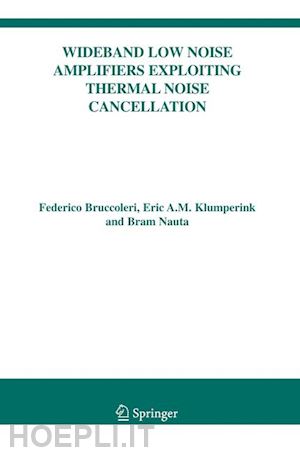
Questo prodotto usufruisce delle SPEDIZIONI GRATIS
selezionando l'opzione Corriere Veloce in fase di ordine.
Pagabile anche con Carta della cultura giovani e del merito, 18App Bonus Cultura e Carta del Docente
Low Noise Amplifiers (LNAs) are commonly used to amplify signals that are too weak for direct processing for example in radio or cable receivers. Traditionally, low noise amplifiers are implemented via tuned amplifiers, exploiting inductors and capacitors in resonating LC-circuits. This can render very low noise but only in a relatively narrow frequency band close to resonance. There is a clear trend to use more bandwidth for communication, both via cables (e.g. cable TV, internet) and wireless links (e.g. satellite links and Ultra Wideband Band). Hence wideband low-noise amplifier techniques are very much needed.
Wideband Low Noise Amplifiers Exploiting Thermal Noise Cancellation explores techniques to realize wideband amplifiers, capable of impedance matching and still achieving a low noise figure well below 3dB. This can be achieved with a new noise cancelling technique as described in this book. By using this technique, the thermal noise of the input transistor of the LNA can be cancelled while the wanted signal is amplified! The book gives a detailed analysis of this technique and presents several new amplifier circuits.
This book is directly relevant for IC designers and researchers working on integrated transceivers. Although the focus is on CMOS circuits, the techniques can just as well be applied to other IC technologies, e.g. bipolar and GaAs, and even in discrete component technologies.
Preface. Chapter 1: Introduction. 1.1 Introduction. 1.2 Motivations. 1.3 Outline. 1.4 References. Chapter 2: Systematic Generation of All Elementary Wide-Band Amplifiers. 2.1 Introduction. 2.2 The Systematic Generation Methodology. 2.2.1 2VCCS graph database: generation and properties. 2.3 Functional Selection of All Elementary Wide-band Amplifiers. 2.3.1 STEP1: Source/Load impedance and functional requirements. 2.3.2 STEP2: Constraints on the two-port {A, B, C, D} parameters. 2.3.3 STEP3: 2VCCS graphs database exploration. 2.3.4 STEP4: Transistor circuits implementation. 2.4 Conclusions. 2.5 References. Chapter 3: 2-MOST Amplifiers: Analysis and Design. 3.1 Introduction. 3.2 Modelling for Hand Calculations. 3.3 Two-port Noise Factor F. 3.4 Amplifiers Performance Analysis. 3.4.1 Small-signal transfers: ZIN, ZOUT, AVF and AVR. 3.4.2 Noise factor. 3.5 Design Example: a 50-900MHz Variable Gain LNA. 3.5.1 Bandwidth. 3.5.2 Noise factor. 3.6 Design. 3.7 Measurements. 3.8 Conclusions. 3.9 References. Chapter 4: Wide-Band Low-Noise Techniques. 4.1 Introduction. 4.2 Noise Factor Considerations. 4.3 F to Impedance Matching Trade-off in Elementary Wide-band LNAs. 4.4 Working Around the Trade-off. 4.5 Breaking the Trade-off via Negative Feedback. 4.6 The Noise Cancelling Technique. 4.6.1 Breaking the 1+NEF barrier. 4.6.2 Noise cancelling generalisation. 4.6.3 Intuitive analysis of noise cancelling. 4.7 Comparison of Noise-Cancelling LNAs. 4.7.1 Noise factor versus device gm2•RS. 4.7.2 Noise factor versus power consumption. 4.7.3 Noise factor versus power consumption with biasing noise. 4.8 Noise Cancelling Properties. 4.8.1 Robustness. 4.8.2 Simultaneous noise and power matching. 4.8.3 Distortion cancelling. 4.9 High-Frequency Limitations to Noise and Distortion Cancelling. 4.9.1 Noise. 4.9.2 Distortion. 4.9.3 Frequency compensation. 4.10 Summary and Conclusions. 4.11 References. Chapter 5: Design of a Decade Bandwidth Noise Cancelling CMOS LNA 5.1 Introduction. 5.2 Design Requirements and LNA Schematic. 5.3 Analysis of the Noise Factor and Bandwidth. 5.3.1 F for in-band frequencies. 5.3.2 F at high frequencies. 5.3.3 Bandwidth. 5.4 LNA Design: NF at Minimum Power Dissipation. 5.5 Validation of the Design Procedure. 5.6 Final Design. 5.7 Measurements. 5.8 Summary and Conclusions. 5.9 References. Chapter 6: Summary and Conclusions. 6.1 Summary and Conclusions. 6.2 References. Appendix A: Two-port Amplifiers Stability and {A, B, C, D} Parameters. Appendix B: Biasing noise in Noise-cancelling Amplifiers. Appendix C: Two-port Amplifiers Noise and Power Matching. Appendix D: All 1- and 2-VCCS Graphs. Index. Author Biographies.











Il sito utilizza cookie ed altri strumenti di tracciamento che raccolgono informazioni dal dispositivo dell’utente. Oltre ai cookie tecnici ed analitici aggregati, strettamente necessari per il funzionamento di questo sito web, previo consenso dell’utente possono essere installati cookie di profilazione e marketing e cookie dei social media. Cliccando su “Accetto tutti i cookie” saranno attivate tutte le categorie di cookie. Per accettare solo deterninate categorie di cookie, cliccare invece su “Impostazioni cookie”. Chiudendo il banner o continuando a navigare saranno installati solo cookie tecnici. Per maggiori dettagli, consultare la Cookie Policy.